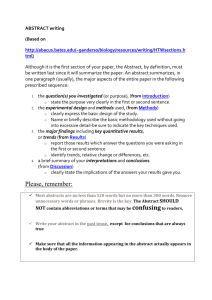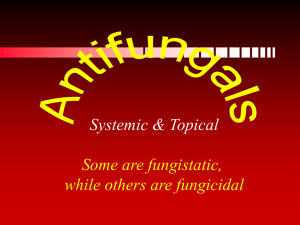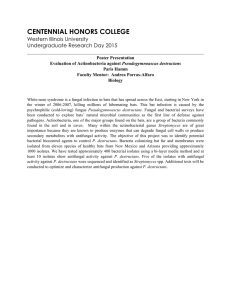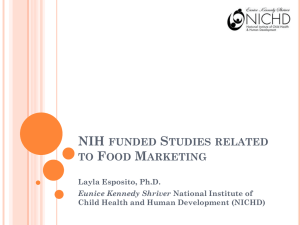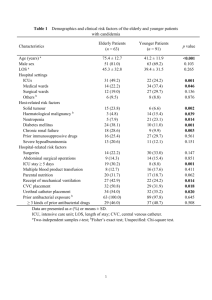Reinvestigation of the antifungal activities ... N-oxides ARABINDA RAY*, S K NOOR MOHAMMADt, ... G V KULKARNI~t
advertisement
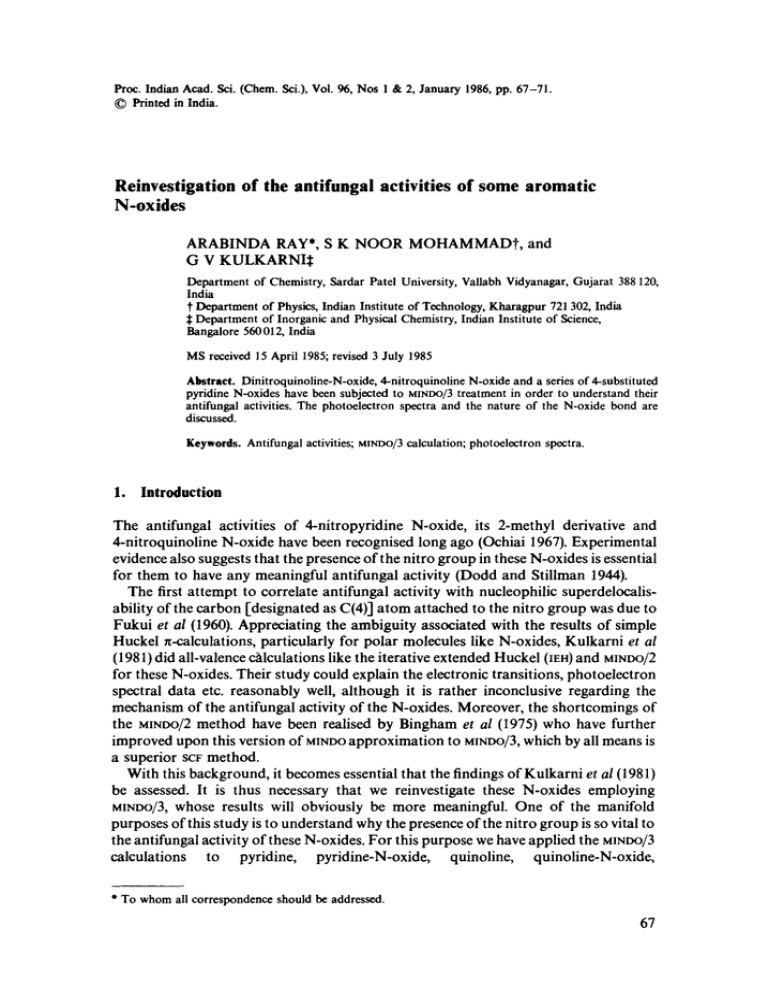
Proc. Indian Acad. Sci. (Chem. Sci.), Vol. 96, Nos 1 & 2, January 1986, pp. 67-71. 9 Printed in India. Reinvestigation of the antifungal activities of some aromatic N-oxides ARABINDA RAY*, S K NOOR MOHAMMADt, and G V KULKARNI~t Department of Chemistry, Sardar Patel University, Vallabh Vidyanagar, Gujarat 388120, India t Department of Physics, Indian Institute of Technology, Kharagpur 721 302, India :I:Department of Inorganic and Physical Chemistry, Indian Institute of Science, Bangalore 560012, India MS received 15 April 1985; revised 3 July 1985 Abstract. Dinitroquinoline-N-oxide,4-nitroquinoline N-oxide and a series of 4-substituted pyridine N-oxides have been subjected to MINDO/3 treatment in order to understand their antifungal activities. The photoelectron spectra and the nature of the N-oxide bond are discussed. Keywords. Antifungal activities; MINDO/3calculation; photoelectron spectra. 1. Introduction The antifungal activities of 4-nitropyridine N-oxide, its 2-methyl derivative and 4-nitroquinoline N-oxide have been recognised long ago (Ochiai 1967). Experimental evidence also suggests that the presence of the nitro group in these N-oxides is essential for them to have any meaningful antifungal activity (Dodd and Stillman 1944). The first attempt to correlate antifungal activity with nucleophilic superdelocalisability of the carbon [-designated as C(4)] atom attached to the nitro group was due to Fukui et al (1960). Appreciating the ambiguity associated with the results of simple Huckel n-calculations, particularly for polar molecules like N-oxides, Kulkarni et al (1981) did all-valence cMculations like the iterative extended Huckel (IE.) and ulNoo/2 for these N-oxides. Their study could explain the electronic transitions, photoelectron spectral data etc. reasonably well, although it is rather inconclusive regarding the mechanism of the antifungal activity of the N-oxides. Moreover, the shortcomings of the MINDO/2 method have been realised by Bingham et al (1975) who have further improved upon this version of MINDOapproximation to Mira)O/3, which by all means is a superior SCF method. With this background, it becomes essential that the findings of Kulkarni et al (1981) be assessed. It is thus necessary that we reinvestigate these N-oxides employing MINUO/3, whose results will obviously be more meaningful. One of the manifold purposes of this study is to understand why the presence of the nitro group is so vital to the antifungal activity of these N-oxides. For this purpose we have applied the MINDO/3 calculations to pyridine, pyridine-N-oxide, quinoline, quinoline-N-oxide, w To whom all correspondence should be addressed. 67 68 Arabinda Ray, S K Noor Mohammad and G V Kulkarni 4-CN/OH/NH2 pyridine-N-oxide and dinitroquinoline-N-oxide, in addition to 4-nitropyridine-N-oxide and 4-nitroquinoline-N-oxide which are proven antifungal compounds. It is also aimed at providing an insight into the mechanism of the antifungal activity of these compounds. In addition, the nature of the N-oxide bond has also been discussed. The energies of occupied orbitals are also compared with the photoelectron spectral data, where available, to judge the reliability of the numerical values obtained from the MINOO/3calculation. All the results of the present study are compared with the findings of earlier authors (Fukui et al 1960; Kulkarni et al 1981). 2. Method of calculation The semi-empirical parameters for the MINDO/3method were taken from Bingham et al (1975), without any modification. The structural parameters, where available, were taken from x-ray data (Eichhorn 1956; Ulku et a11971) and otherwise, were transferred from related molecules. In the absence of optimisation, it was essential to keep the lengths of similar bonds, and the magnitudes of comparable angles, constant in all molecules, so that the change of electronic environment due to the variation of functional groups mainly influences the orbital energies. 3. 3.1 Results and discussion Photoelectron spectra and orbital energies The ionisation energies obtained from MINOO/3 calculations are compared with the observed uv photoelectron spectral data in table 1. The photoelectron (PE) spectra of pyridine-N-oxide and a number of substituted derivatives have been reported by Weiner and Lattman (1974) and by Maier and Muller (1974). These two reports, however, have provided different assignments for the first and second ionisation processes in pyridine-N-oxide. The PE band observed at 8"38 eV for this compound has been assigned (Weiner and Lattman 1974) to ionisation from the highest occupied a-MO (mainly from oxygen), while Maier and Muller (1974) assigned this to the highest occupied 7t-MO. The results of the present investigation agree with Maier and Muller's view. This band (calcd. at 9.01 eV) corresponds to the highest occupied 7t-MOhaving a major contribution from the O-atom. It is interesting to note that like pyridine-N-oxide, in all its derivatives studied, the highest occupied molecular orbitals (HOMO)are of the n-type having a major contribution from the oxygen of the Noxide moiety, with varying degrees of contribution from the ring atoms. The latter affect the HOMOenergy substantially. However, for 4-NH2 PNO, (PNty--pyridine-Noxide), contributions from the N atom of the -NH2 group and the oxygen of the Noxide moiety are comparable; this factor has considerably lowered the energy of the HOMOfor this molecule, compared to the others in this series. In most of these PNO compounds, a fairly invariant bond at ~ 10.30 eV due to the n-electrons of the ring carbon atoms is obtained from the calculation. This band however, appears at 10"85 eV in 4 NO2 "PNO.The present assignments do not differ much from those of Kulkarni et al (1981). Antifunoal activities of some aromatic N-oxides 69 Table 1. Ionization energies (eV). Compound Method I~* 12 13 14 Pyridine Obs. MINDO/3 PNO** Obs. MINDO/3 4CN- PNO Obs. MINDO/3 4NO2" PNO Obs. MINOO/3 4NH2" PNO MINDO/3 13-0 10"39 (~) 11.59 11"13 (~) 11.58 10-35 (n c) 11-26 10-85 (nC) 10"30 MINDO/3 QNO** MINDO/3 4NO2 . Q N O M1NDO]3 10-50 9"18 (,tc) 9-22 9"87 (o~ ) 9-74 9"98 (a) 9.80 ,10"65 (a) 9"70 (.) 9"87 (*) 9"56 (,tc) 9-72 (a) 12.27 9"81 (n c, N) 10-18 10-34 (n c ) 10-84 10"09 (~r) 10-81 10-66 (~) 10-11 4OH' PNO 9-26 854 O) 8.38 9"01 (n ~ ) 8-95 8"95 (n ~ ) 9-03 9"71 (nO) 8"04 (no, ~) 8"55 (n ~ ) 7"99 (nc, o) 8'52 (nC, O) (nc) (~N, o) 10-33 (n c ) 9.66 (a) 9-91 (,~C) 11"20 (~) 9"87 (no, c) 10-07 (O) * li (i = 1-4) stands for the ith ionisation energy from MINDO/3calculations; ** Pyridine-N-oxide is designated as PNO, and quinoline-N-oxide as QsO. Table 2. Population of nitrogen and oxygen atoms in the N-oxide moiety. Population N O Compounds* s px Py p, s Px Py Pz Pyridine PNO 4CN. PNo 4NOz" PNO 4NH2-1,NO 4OH. PNo QNO 4NOz'QNO 1.60 1.30 1.27 1.27 1.27 1-27 1.30 1-30 1.10 0-99 0-99 0-99 0-98 0-99 0-99 0-99 1.32 1.00 0-98 0-98 0-98 0-98 0-97 0-98 1-13 1.05 1.03 0-99 1.09 1.09 1.04 0-97 1.94 1"92 1-92 1"92 1.92 1.92 1.91 1.70 1.68 1.69 1"68 1.67 1-73 1.71 1.17 1.24 1.24 1'23 1.23 1.21 1.27 1.84 1.79 1-77 1.83 1.82 1.77 1.71 * Abbreviations as in table 1. 3.2 Nature of the N-oxide bond It is e v i d e n t f r o m t a b l e 2, that in all these N - o x i d e s , the typical h y b r i d i s a t i o n o n the o x y g e n a t o m o f the N - o x i d e m o i e t y is s ~ 1.9p ~ zg. T h e r e is a l m o s t an entire l o n e pair o f e l e c t r o n s in the P2 o r b i t a l (which is p e r p e n d i c u l a r to the p l a n e o f the ring) o f the o x y g e n a t o m in the N - o x i d e f r a g m e n t . So for all p r a c t i c a l p u r p o s e s , the N - O b o n d in the 70 Arabinda Ray, S K Noor Mohammad and G V Kulkarni N-oxide moiety is more o f a single b o n d than a double bond. This is in contrast to the earlier observation o f Kulkarni et al (1981), where this bond. was predicted to be fairly close to a double bond. The m o d e o f hybridisation o f nitrogen (s ~ L6p ~ 2.4~) in pyridine however changes to s " 1.3p ~ L96in the pyridine-N-oxide. This may be traced to the higher electronegativity o f the oxygen atom. It is interesting to note that the ' N O ' b o n d o f the N-oxide moiety is different f r o m that in an - N O 2 group. In the latter the P2 electrons are m o r e delocalised to give the N O b o n d an appreciable n - b o n d character. 3.3 Antifunoal activity It has been suggested f r o m experimental studies on these antifungal n i t r o - c o m p o u n d s that the m o d e o f action involves interference with either a sulphydryl enzyme or the nitro-reduction system o f the micro-organism (Fukui et al 1960). A m o n g s t the c o m p o u n d s listed in table 3, 4-nitroquinoline-N-oxide has the highest antifungal activity followed by 4-nitropyridine-N-oxide. It is important to note that dinitroquinoline-N-oxide does n o t have the activity. T o answer the various questions associated with antifungal activity, a systematic examination o f the effects o f attaching an oxygen a t o m to the nitrogen o f the ring, and also o f introducing a nitro g r o u p at the fourth position in the ring, is o f prime importance. So far as the energy o f the lowest unoccupied molecular orbital (LUMO) gives a measure o f the electron accepting ability o f these molecules, the simple N-oxides are better n-acceptors (and accordingly more reactive towards nucleophiles) than the parent compounds. Thus pyridine-N-oxide is m o r e reactive towards nucleophiles as c o m p a r e d to pyridine (table 3). Also, on comparing the energy o f the LUMOo f pyridine, Table 3. Energies* of HOMOand LUMOof substituted N-oxides. Energy (eV) Compound HOMO LUMO Pyridine (Py) 4NO2" lay - 9"17 - 9.90 1"26 - 0-26 PNO -- 9"01 4NO2 9Pl~O 4CN. PNO 4OH. PNO 4NH2" plqo Quinoline QNO 4NO2" QNO Dinitroquinoline-N-oxide -9-71 --8'95 - 8"55 - 8"04 - 8.16 --7"99 -- 8"52 - 8.91 0"45 -0-73 0"18 0-26 0-49 0"23 --0"14 -- 0"75 - 1"31 * For pyridine and 4NO2-pyridine the HOMOare of the a-type while they are of the z-type for the remaining compounds. However, for the sake of comparison, the energy of n-HOMOof these compounds are shown in the table. The LUMOon the other hand are all n-type. Antifungal activities of some aromatic N-oxides 71 pyridine-N-oxide and 4-nitropyridine, it is obvious that the introduction of a nitrogroup at the C(4) position has made 4-nitropyridine a better electron acceptor than pyridine and pyridine-N-oxide. It is thus apparent that the combined effect of N-oxidation and introduction of a nitro-group at the C(4) position is to make the compound more reactive towards nucleophiles. Thus, 4-nitropyridine-N-oxide is the best n-acceptor amongst all the pyridine compounds listed in table 3. For the same reason 4-nitroquinoline-N-oxide is a better electron acceptor than quinoline and quinoline-N-oxide. We now find a correlation between the ability to accept electrons and the antifungal activity. The two powerful antifungal agents, 4-nitroquinoline-N-oxide and 4-nitropyridine-N-oxide are good n-acceptors. The C(4) atoms in 4-NO2"PNO and 4 NO2.or~o---quinoline-N-oxide) have the highest frontier (LUMO) electron density amongst the C-atoms in the respective molecules and hence are the most probable sites for nucleophilic attack by the SH- group. Of these two compounds 4-NO2- QNo is a more potent antifungal agent than 4-NO2-PNO. Unfortunately, the energies of the LUMO of these compounds are quite comparable and hence not of much help in understanding their relative order of activity as antifungal agents. As optimisation of bond parameters was not carried out, the extent to which the energies of the LUMOcan account for the relative order of activity remains indeterminate. It is interesting to note that comparison of nucleophilic superdelocalizability of the C(4) atom in 4-NO2 9PNo and in 4-NO2 9QNo could not provide support to Fukui et al (1960). Since the antifungal activities of these N-oxides appear to be due to their ability to accept electrons, one may wonder why dinitroquinoline-N-oxide, the most powerful electron acceptor in the series (table 3) does not show antifungal activity. The nonactivity of dinitroquinoline-N-oxide may be traced to the fact that this compound, being an extremely powerful oxidising agent, gets destroyed before reaching the appropriate enzyme site. 4. Conclusion In conclusion, it may be said that the antifungal activities of these nitro-aromatic N-oxides depend on their ability to act as good electron acceptors. The SH- attacks the C(4) atom, which has the highest frontier electron density (LUMO)in the respective molecules. No simple relation between antifungal activity and superdelocalizability could be obtained. References Bingham R C, Dewar M J S and Lo D H 1975 J. Am. Chem. Sac. 97 1285 Dodd M C and Stillman W B 1944 J. Pharmacol. Exp. Theor. 82 11 Eichhorn G L 1956 Acta Crystallogr. 9 787 Fukui K, Imamura A and Nagata C 1960 Bull. Chem. Sac. Jpn 33 122 Kulkarni G V, Ray A and Patel C C 1981 J. Mol. Struct. 7! 253 Maier J P and Muller J F 1974 J. Chem. Sac. Faraday Trans. 2 70 Ochiai E 1967 Aromatic amine oxides (Amsterdam: Elsevier) Uiku D, Huddle B P and Marrow J C 1971 Acta Crystallogr. B27 432 Weiner M A and Lattman M 1974 Tetrahedron Lett. 1709
